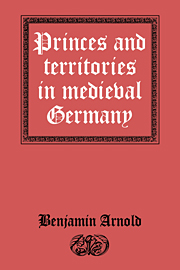Book contents
- Frontmatter
- Contents
- Acknowledgements
- List of abbreviations
- Introduction
- PART I CROWN AND PRINCE
- PART II PRINCELY TITLE AND OFFICE
- 4 The imperial house; German bishops and abbots
- 5 Dukes and duchies
- 6 Counts and the transformation of counties
- 7 Margraves, counts-palatine, burgraves, and landgraves
- PART III DYNASTIES, PRELATES, AND TERRITORIAL DOMINION
- Conclusion
- Index
7 - Margraves, counts-palatine, burgraves, and landgraves
Published online by Cambridge University Press: 03 December 2009
- Frontmatter
- Contents
- Acknowledgements
- List of abbreviations
- Introduction
- PART I CROWN AND PRINCE
- PART II PRINCELY TITLE AND OFFICE
- 4 The imperial house; German bishops and abbots
- 5 Dukes and duchies
- 6 Counts and the transformation of counties
- 7 Margraves, counts-palatine, burgraves, and landgraves
- PART III DYNASTIES, PRELATES, AND TERRITORIAL DOMINION
- Conclusion
- Index
Summary
Although the traditional royal and aristocratic powers made manifest through counties and duchies had atrophied by the end of the eleventh century, the titles themselves continued as part of the German aristocratic apparatus, being valued very highly for the prestige and honour which they conferred upon dynasties and certain cathedral churches. Associated with the new types of princely jurisdiction characteristic of the twelfth and thirteenth centuries, the titles were remoulded to suit the political transmutation of the German regions. The titles adorned and in part justified the autonomous powers of dynasties based upon their holdings in land. They also adorned the local jurisdications which were no longer royal commissions except for the overriding purpose of enforcing the Landfrieden. And the titles continued to justify aristocratic military command now so dependent upon building stone castles and enfeoffing personal retinues of vassals and ministeriales. In the great majority of cases the twelfth-century comitatus was the hereditary and allodial possession of a dynasty called after a castle. In their written or spoken meaning all the secular titles of the German princes signified some official, judicial, or military function, and continued to do so; but now they were subordinate to dynastic succession, honour, and authority.
Four further titles more or less equivalent to count were affected by the same processes in the later eleventh and twelfth centuries: margrave, count-palatine, burgrave, and landgrave. In September 1151, for example, we find them together at the royal court held in Würzburg which was attended by the margraves of Meissen and Brandenburg, the landgrave of Thuringia, the burgraves of Mainz, Wiirzburg, and Bamberg, and the count-palatine of Bavaria.
- Type
- Chapter
- Information
- Princes and Territories in Medieval Germany , pp. 121 - 132Publisher: Cambridge University PressPrint publication year: 1991

